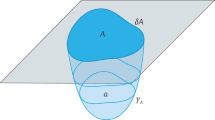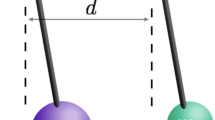Abstract
Reconciling quantum mechanics with gravity has long posed a challenge for physicists. Recent developments have seen concepts originally developed in quantum information theory, such as entanglement and quantum error correction, come to play a fundamental role in understanding quantum gravity.
This is a preview of subscription content, access via your institution
Access options
Access Nature and 54 other Nature Portfolio journals
Get Nature+, our best-value online-access subscription
$29.99 / 30 days
cancel any time
Subscribe to this journal
Receive 12 print issues and online access
$209.00 per year
only $17.42 per issue
Buy this article
- Purchase on Springer Link
- Instant access to full article PDF
Prices may be subject to local taxes which are calculated during checkout





Similar content being viewed by others
References
Bekenstein, J. D. Black holes and the second law. Lett. Nuovo Cim. 4, 737–740 (1972).
Bekenstein, J. D. Black holes and entropy. Phys. Rev. D 7, 2333–2346 (1973).
Hawking, S. W. Gravitational radiation from colliding black holes. Phys. Rev. Lett. 26, 1344–1346 (1971).
Hawking, S. W. Black hole explosions? Nature 248, 30–31 (1974).
Susskind, L. The world as a hologram. J. Math. Phys. 36, 6377–6396 (1995).
Bousso, R. The holographic principle. Rev. Mod. Phys. 74, 825–874 (2002).
’t Hooft, G. Dimensional reduction in quantum gravity. Preprint at https://arxiv.org/abs/gr-qc/9310026 (1993).
Maldacena, J. The large-N limit of superconformal field theories and supergravity. Int. J. Theor. Phys. 38, 1113 (1999).
Witten, E. Anti de Sitter space and holography. Adv. Theor. Math. Phys. 2, 253–291 (1998).
Gubser, S. S., Klebanov, I. R. & Polyakov, A. M. Gauge theory correlators from non-critical string theory. Phys. Lett. B 428, 105–114 (1998).
Ryu, S. & Takayanagi, T. Holographic derivation of entanglement entropy from the anti–de Sitter space/conformal field theory correspondence. Phys. Rev. Lett. 96, 181602 (2006).
Hubeny, V. E., Rangamani, M. & Takayanagi, T. A covariant holographic entanglement entropy proposal. J. High Energy Phys. 2007, 062 (2007).
Faulkner, T., Lewkowycz, A. & Maldacena, J. Quantum corrections to holographic entanglement entropy. J. High Energy Phys. 2013, 074 (2013).
Van Raamsdonk, M. Building up spacetime with quantum entanglement. Gen. Relativ. Gravit. 42, 2323–2329 (2010).
Maldacena, J. & Susskind, L. Cool horizons for entangled black holes. Fortschr. Phys. 61, 781–811 (2013).
Hayden, P., Headrick, M. & Maloney, A. Holographic mutual information is monogamous. Phys. Rev. D 87, 046003 (2013).
Almheiri, A., Dong, X. & Harlow, D. Bulk locality and quantum error correction in AdS/CFT. J. High Energy Phys. 2015, 163 (2015).
Hubeny, V. E. & Rangamani, M. Causal holographic information. J. High Energy Phys. 2012, 114 (2012).
Headrick, M., Hubeny, V. E., Lawrence, A. & Rangamani, M. Causality & holographic entanglement entropy. J. High Energy Phys. 2014, 162 (2014).
Harlow, D. The Ryu–Takayanagi formula from quantum error correction. Commun. Math. Phys. 354, 865–912 (2017).
Swingle, B. Entanglement renormalization and holography. Phys. Rev. D 86, 065007 (2012).
White, S. R. Density matrix formulation for quantum renormalization groups. Phys. Rev. Lett. 69, 2863–2866 (1992).
Verstraete, F., Murg, V. & Cirac, J. I. Matrix product states, projected entangled pair states, and variational renormalization group methods for quantum spin systems. Adv. Phys. 57, 143–224 (2008).
Vidal, G. Class of quantum many-body states that can be efficiently simulated. Phys. Rev. Lett. 101, 110501 (2008).
DiVincenzo, D. P. et al. in Quantum Computing and Quantum Communications (ed. Williams, C. P.) 247–257 (Springer, Berlin, 1999).
Pastawski, F., Yoshida, B., Harlow, D. & Preskill, J. Holographic quantum error-correcting codes: toy models for the bulk/boundary correspondence. J. High Energy Phys. 2015, 149 (2015).
Yang, Z., Hayden, P. & Qi, X.-L. Bidirectional holographic codes and sub-AdS locality. J. High Energy Phys. 2016, 175 (2016).
Hayden, P. et al. Holographic duality from random tensor networks. J. High Energy Phys. 2016, 9 (2016).
Page, D. N. Average entropy of a subsystem. Phys. Rev. Lett. 71, 1291–1294 (1993).
Strominger, A. The dS/CFT correspondence. J. High Energy Phys. 2001, 034 (2001).
Nomura, Y., Salzetta, N., Sanches, F. & Weinberg, S. J. Toward a holographic theory for general spacetimes. Phys. Rev. D 95, 086002 (2017).
Verlinde, E. Emergent gravity and the dark universe. SciPost Phys. 2, 016 (2017).
Han, M. & Huang, S. Discrete gravity on random tensor network and holographic Rényi entropy. J. High Energy Phys. 2017, 148 (2017).
Lashkari, N., McDermott, M. B. & Van Raamsdonk, M. Gravitational dynamics from entanglement “thermodynamics”. J. High Energy Phys. 2014, 195 (2014).
Swingle, B. & Van Raamsdonk, M. Universality of gravity from entanglement. Preprint at https://arxiv.org/abs/1405.2933 (2014).
Shenker, S. H. & Stanford, D. Black holes and the butterfly effect. J. High Energy Phys. 2014, 67 (2014).
Larkin, A. & Ovchinnikov, Y. N. Quasiclassical method in the theory of superconductivity. J. Exp. Theor. Phys. 28, 1200–1205 (1969).
Shenker, S. H. & Stanford, D. Stringy effects in scrambling. J. High Energy Phys. 2015, 132 (2015).
Maldacena, J., Shenker, S. H. & Stanford, D. A bound on chaos. J. High Energy Phys. 2016, 106 (2016).
Sachdev, S. & Ye, J. Gapless spin-fluid ground state in a random quantum Heisenberg magnet. Phys. Rev. Lett. 70, 3339–3342 (1993).
Kitaev, A. A simple model of quantum holography. KITP http://online.kitp.ucsb.edu/online/entangled15/kitaev/; http://online.kitp.ucsb.edu/online/entangled15/kitaev2/ (2015).
Maldacena, J. & Stanford, D. Remarks on the Sachdev-Ye-Kitaev model. Phys. Rev. D 94, 106002 (2016).
Almheiri, A., Marolf, D., Polchinski, J. & Sully, J. Black holes: complementarity or firewalls? J. High Energy Phys. 2013, 62 (2013).
Stanford, D. & Susskind, L. Complexity and shock wave geometries. Phys. Rev. D 90, 126007 (2014).
Brown, A. R., Roberts, D. A., Susskind, L., Swingle, B. & Zhao, Y. Holographic complexity equals bulk action? Phys. Rev. Lett. 116, 191301 (2016).
Susskind, L. Dear Qubitzers, GR=QM. Preprint at https://arxiv.org/abs/1708.03040 (2017).
Acknowledgements
This work is supported by the National Science Foundation under grant no. 1720504.
Author information
Authors and Affiliations
Corresponding author
Additional information
Additional information
Reprints and permissions information is available at www.nature.com/reprints. Correspondence should be addressed to X.-L.Q.
Publisher’s note: Springer Nature remains neutral with regard to jurisdictional claims in published maps and institutional affiliations.
Rights and permissions
About this article
Cite this article
Qi, XL. Does gravity come from quantum information?. Nature Phys 14, 984–987 (2018). https://doi.org/10.1038/s41567-018-0297-3
Received:
Accepted:
Published:
Issue Date:
DOI: https://doi.org/10.1038/s41567-018-0297-3
This article is cited by
-
The QBIT Theory: Consciousness from Entangled Qubits
Integrative Psychological and Behavioral Science (2022)
-
Multipartite entanglement of billions of motional atoms heralded by single photon
npj Quantum Information (2021)
-
Programmable interactions and emergent geometry in an array of atom clouds
Nature (2021)
-
The QBIT Theory of Consciousness
Integrative Psychological and Behavioral Science (2020)
-
Dynamics of quantum information
Nature Reviews Physics (2019)



